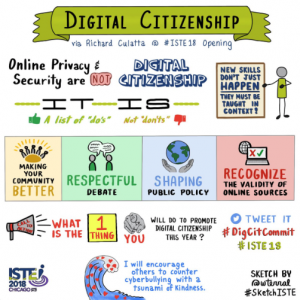This week you will examine digital citizenship and how this will impact critical digital literacies. Citizenship is more about what individuals DO in their everyday lives, but many focus their efforts on what people should not do as a citizen of the world, in real and digital spaces.
DATES: Nov 17-23rd
READINGS:
- Course web site for week eleven
- Mapping Digital Literacy: Policy and Practice in the Canadian Education Landscape pg 8, pages 43-54
- Media Smarts Canada – Think Before You Share
- ISTE – It’s Time to Commit to Digital Citizenship
TOPICS: Digital citizenship is a complex concept that impacts your teaching and learning, as well as future digital engagements for your students. The ISTE article identifies some new ideas. Wanda Terral shares her sketchnote  from the keynote talk held at the ISTE Conference in June, 2018, with a focus on the DO’s rather than the DON’Ts of digital citizenship. How does this compare to your classroom and teaching experiences with digital tools and resources? In the Mapping Digital Literacies document, the role of teachers is identified in three specific ways. How do these roles resonate for you as you consider yourself as a teacher? Which role do you think will make the biggest impact on your digital teaching practices?
from the keynote talk held at the ISTE Conference in June, 2018, with a focus on the DO’s rather than the DON’Ts of digital citizenship. How does this compare to your classroom and teaching experiences with digital tools and resources? In the Mapping Digital Literacies document, the role of teachers is identified in three specific ways. How do these roles resonate for you as you consider yourself as a teacher? Which role do you think will make the biggest impact on your digital teaching practices?
Thank you @rec54 for a motivating opening to #ISTE18 #DigCitCommit #SketchISTE #NotAtISTE #sketchnotes pic.twitter.com/1n3YaDzyKj
— ????? ?????? (@wterral) June 25, 2018
Using this sketchnote created by Sylvia Duckworth, analyze your own digital citizenship practices. How will you model digital citizenship as you create a professional, digital persona and teach using digital technologies? How will you determine what to DO or DON’T DO as a responsible citizen in digital spaces? How does this compare/contrast to the image found in the Mapping Digital Literacy document from Media Smarts Canada, page 8?
ACTIVITIES:
- Last week you did a web search using a variety of search engines. This week you can try some search tools that are specifically designed for use with students. See the list provided by ISTE and tinker to learn how each can provide information for your students on a specific topic you may be teaching, such as ‘polar bears’.
- Integrate some of the information and topics from last week and this week into your final blog post, due next week.
- Continue to play and tinker with some Creative Make activities that you haven’t tried yet. These can also be integrated into your final blog post.
- Work to complete your MINDOMO concept map. If you would like some feedback on your map, before you submit it as part of your final blog submission, send the access link to Helen so it can be reviewed. [see how to share a Mindomo map in the LAB section on Mindomo]
TASKS to COMPLETE:
- A1: Discussion post in D2L by Tuesday at 11:59 p.m.
- A1: Two responses by Friday at 11:59 p.m.
- A2: ONE comment to a blog post on Helen’s blog site by Saturday at 11:59 pm (see suggested list on the course site).
REFLECTION:
What are the essential skills you will need to model as a ‘good digital citizen’? How is this different than being a ‘regular citizen’ in the real world?
What have you learned about the use of sketchnotes to create digital content, as modelled by Sylvia Duckworth and Wanda Terral? How does sketchnoting fit into the framework of critical digital literacy – code breaking, meaning making, using, understanding, creating, and sharing? Where can sketchnoting be used in your teaching practice?

